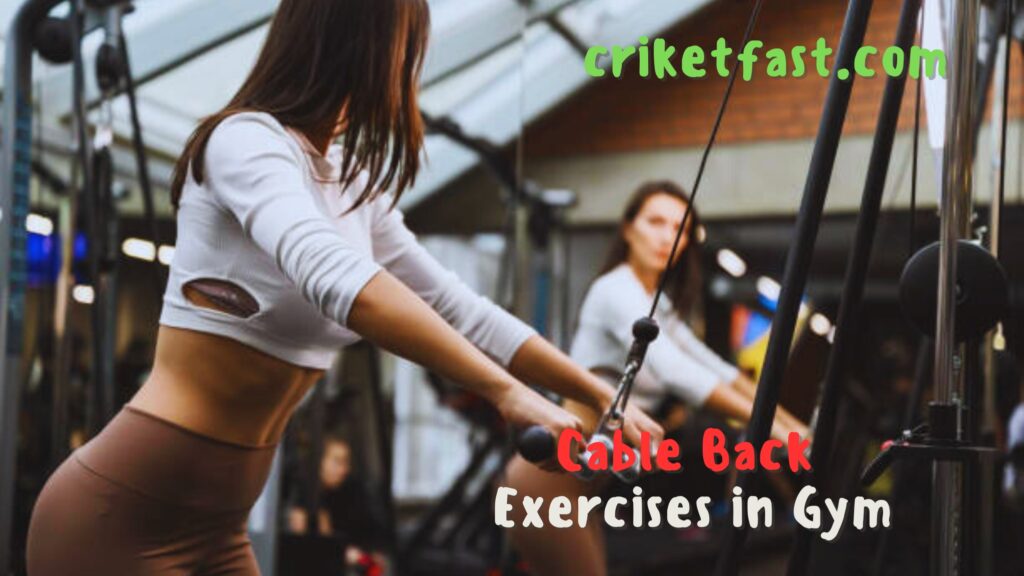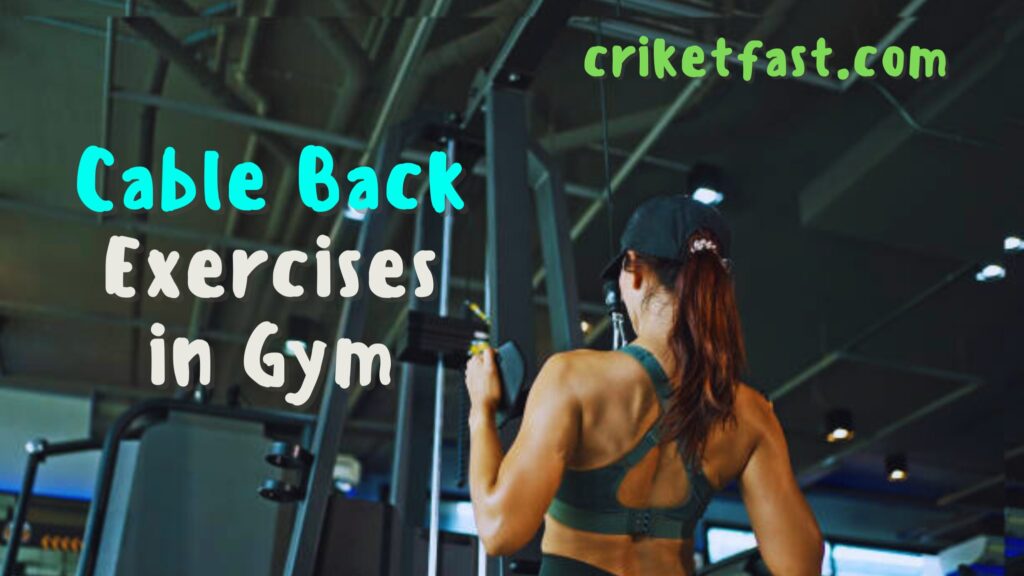The Best Cable Back Exercises in Gym for Girls
Cable Back Exercises can provide incredible benefits in terms of strengthening, thickness, and width of the back. Doing back exercises with a cable machine can also help to increase your other large compound lifts like deadlifts or overhead presses.
Different attachments, angles, and weights allow the cable machine to target all of the major and minor muscles in your back.
Cable exercises for the back allow you to flex your arms without putting too much strain on your joints. They also provide constant tension to your muscles, which dumbbells cannot do.
What are the Muscles of the back?
While cable back exercises target many of your 40 back muscles, we’ll focus on the primary muscles first. These are the large muscles that are easy to overlook because they are so superficial.
Trapezius: Trapezius, also known as the trap muscle, is one of the largest and most prominent muscles in the upper back.
It’s a pair of large, triangular muscles that extend from the base of your skull (occipital bone) to the bottom of your thoracic spine (scapulae). The primary job of these muscles is to hold your arms in place and move your scapulae around. If you want to have a barn door-like back, you’ll need to work on constructing your traps.
Rhomboids: You have two rhomboids in your upper back, one on each side.
Under the traps are the rhomboids. They run from the base of the spine to the base of your scapula. The name rhomboids comes from their quadratic shape. Each rhomboid has one major muscle and one minor muscle.

5 Best Cable Back Exercises
The cable back exercises listed below are ranked based on experience, beginning with exercises that are recommended for beginners and progressing to more advanced strength-building exercises. Please note that all techniques, correct forms, reps, and set suggestions are provided for your benefit.
1۔ Seated cable row
This back exercise is a great way to get the most out of your back while also working on your arms. It’s a simple, yet effective way to get your core in shape.
Weighted horizontal cable row machines are the perfect tool for this back exercise.
How to do it:
- On the machine, sit with your knees bent and feet on the front of the machine.
- Grab the handles and lean forward while keeping your back neutral and your knees relaxed.
- Keep your elbows tight to your rib cage.
- Keep your torso at a 90-degree angle to your legs and keep your core engaged for stability, then pull the handles towards your abs.
- Press down on your shoulder blades while keeping your torso flat. Avoid bending at the waist to increase the force.
- Slowly return the handle to the machine to the starting position.
Recommended sets and reps: 3 to 5 sets of 8 repetitions.
1۔ Seated single-arm row
The single arm cable row (also known as the seated single arm cable row) is the same as the two arm variation, except the work is done one-side at a time. It’s great for indirect core training stimulus, and the single-arm version works well when you can’t load enough. Make sure you’re loading a weight that’ll allow you to pull the entire range of motion.
How to do it:
- On the machine, put your hands on the front of the machine and lean forward with one hand, keeping your back neutral and your knees flexed.
- Keep your elbow close to your ribcage.
- Make sure your torso is 90 degrees away from your legs and your core engaged to keep your back stable, especially when using higher weights.
- Pull the handle toward your working side abdominals.
- Rotate your torso as all of the force is going to be on one side, so keep your torso stationary and squeeze your working side shoulder blades.
- Then slowly pull the handle back to the beginning position.
Recommended sets and reps: 3 to 5 sets of 8 repetitions.
3۔ Seated single-arm row with rotation
Rotation is an integral part of your day-to-day activities and activities, as well as for many athletic movements. As a result, incorporating rotation into your rowing routine gives you a natural feel, as few human movements occur in isolation. While isolated rowing techniques can effectively target specific muscle groups, including rotation in your rowing routine is necessary to reap the benefits for the entire range of motion, as long as the weight you are using is light enough for proper rotation.
How to do it:
- Sit on the machine, bend your knees and place your feet on the front platform.
- Grab the handle and lean forward with one hand while keeping your back neutral and your knees relaxed.
- Keep your elbow tight to your rib cage.
- Keep your torso at a 90-degree angle to your legs and keep your core engaged to support your back. Let your torso rotate a bit.
- As the handle is pulled towards the working side of the rib cage, rotate from the waist up as the hand gets closer to the torso.
- The contraction should be held at the peak of your movement before the cable pulls you back into your initial position.
Recommended sets and reps: 3 to 5 sets of 8 repetitions.

4۔ Seated lat pulldowns
The Latissimus Doris muscle is the biggest muscle in your back. Doing a lat pulldown on the cable machine can be one of the best ways to stimulate the latissimus Dorsi. Good posture and spine stability depend on having strong lat muscles. Lat pulldowns are the best way to lead-in to pull-ups. For beginners, use lighter weights and increase the load as you go.
How to do it:
- Sit at the cable machine with your knees snug to the knee pad and the bar attached to the top pulley.
- With your arms extended overhead and your chest upright, exhale and squeeze your shoulder blades back and down.
- Pull the bar down fast without leaning into the pull, until it lightly touches your upper chest.
- With your arms still straight overhead, slowly return the bar to the starting position. Maintain the fast pulldown and slow raise throughout the reps.
Recommended sets and reps: 3 to 5 sets of 8 repetitions.
5۔ Straight arm pulldowns
Straight-arm pull downs are a single-arm isolation exercise that is best done on a cable machine with a low weight and a strict form. The movement is initiated from the shoulders while keeping the elbows straight. Straight arm pulldowns target the shoulders, the upper back and the arms.
How to do it:
- Begin the straight arm pulldown with the pulley at a high angle and the straight bar at a short angle.
- Take a few steps back, bending your torso at the waist and extending your arms at your elbows.
- Tighten your lats without shifting your body position. Pull the bar down so your hands are next to your thighs.
- Slowly return the bar back to the start position.
Recommended sets and reps: 3 to 5 sets of 12 reps.
BENEFITS OF DOING BACK CABLE EXERCISES
If you are unsure whether the cable back exercises are as great as we say, look at the benefits listed below.
1. Range of Motion
When you use a cable machine, the range of motion is way more than what you can get with free weights. Lats are often hard to target with regular exercises, but with a cable machine, it’s easy to target them. One of the best things about cables is that you can tailor the pull angle to target different parts of your back. For example, if you use high pulleys, you can target the upper back, and if you use low, you can target your lower back.
2. Isolation
When you do cable back exercises, you can even isolate certain muscles. This can make a huge difference when you’re dealing with muscle imbalance. By providing constant tension, you’ll have a much better chance of getting your barn door back up.
For instance, if you’re doing free weight rows, you’ll only be working your bicep and traps. But if you’re doing rows on a cable machine, you’ll be able to isolate your lats completely. All you have to do is turn your grip from your underhand to your overhand.
3. Versatility
With so many back exercises to choose from, the cable machine has something for everyone. Whether you’re a beginner, an experienced lifter, a body weight lifter, a metabolism lifter, or a health-conscious lifter, you’re sure to find a cable back workout that’s perfect for you.
For those who don’t have access to a gym membership, here’s some advice. If you’re on a tight budget, you can easily rig your own cable station by attaching a few small attachments to your door.
Let’s now look at the top seven cable back workouts.
Conclusion
In conclusion, cable back exercises are beneficial for strengthening and increasing the size of the back muscles. They also provide a range of motion, isolation of specific muscles, and versatility for different fitness levels.
Read
- The Best Lower Trap Workouts In Gym 2024
- The Most Powerful Short Head Tricep Exercises At Gym
- Upper Butt Workout: Sculpting Your Glutes to Perfection
- The Best Gluteus Minimus Workout For Women’s in GYM
- The Best Hamstring Workout For Women’s in 2024

FAQs
Q1: What are the benefits of cable back exercises?
A: The cable back exercises increase the strength, thickness, and width of the back, as well as improving the performance of other compound lifts.
Q2: Why are cable back exercises better than dumbbell exercises?
A: Cable exercises put pressure on your muscles and joints at the same time.
Q3: What is the best cable back exercise for beginners?
A: Seated cable row is a beginner-friendly exercise that effectively targets the back and arms.
Q: What are rhomboids?
A: A rhomboid is a quadratic muscle in your upper back that runs from your spine to your scapula.

